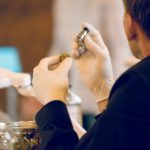
Let me ask you this: who walks into a liquor store and asks for the beer with the highest alcohol content?
If you find yourself raising your hand, you may be a certifiable party animal (and/or an alcoholic)—but, trust me, you don’t know how to appreciate good beer.
It makes me cringe when my budtender friends tell me that the highest-THC-content flower is always the one that sells out first because it is by far the most common request they receive from patrons.
Truly, this is a clear sign of consumers who are still struggling to understand how to make their purchase, coupled with an endemic industry-wide failure on the part of cannabis “retail specialists” to provide the unbiased, fact-based guidance that clients deserve.
We have all been told that THC content tells you how potent a particular cultivar will be, right? Well, think again.
Although this may be true for some people, it most certainly is not true for all of us. I have personally experienced being brought to my knees by a 14-percent-THC Congolese, even though I typically smoke Kush varieties with a 25-percent-plus THC content.
This is because other compounds found in the plant—like terpenes, flavonoids, and other cannabinoids aside from THC (like THCV, CBN, CBD)—vary substantially between these two varieties.
Each of us has a different degree of sensitivity to each of the naturally occurring compounds found in cannabis.
People who use cannabis as part of their daily routine tend to want more out of their experience than just “getting high”—they want a rich, flavourful experience that leads them to the right kind of high. Whether this means relaxation, obtaining energy/inspiration, or killing pain, we are all mostly looking for that special flavour that will take us to that place.
Some people do, in fact, have a high degree of sensitivity, primarily to THC, but most with experience smoking a broad set of cannabis genetics will tell you that they are more focused on finding the genetic that provides that beloved flavour/effect.
Yes, THC is a key component of any intoxicating cannabis biochemical profile, as it does work to augment the psychotropic properties of other components, but THC alone does not determine how long the high will last, how deep it will go, or the type of emotions, feelings, or therapeutic effects it will trigger. This nuanced effect produced by the complex biochemical load of a particular cannabis variety is referred to as the “entourage effect”.
To complicate the story further, different people experience the high from the same plant differently, making it hard to make a one-size-fits-all prediction of how a particular cultivar will affect a specific person.
This is explained by the fact that the number, location, and sensitivity of cannabinoid receptors in the body vary from person to person. For this reason, knowing the THC content is not nearly as reliable in terms of predicting potency as, say, knowing the alcohol content.
When it comes to re-educating the public about THC content as the end-all measure of a flower’s worth, what I recommend to my budtender friends is the following: discard the words indica and sativa as ways of describing effects and focus instead on specific varieties and how their different gene pools relate to certain types of nuanced aromas, flavours, effects, and physical appearance.
Use descriptions of flowers that were previously enjoyed by your client to find something in stock that is at least relatively close to those variety type(s). When you see a preference for a specific type of flower, always contextualize the information as follows: “To me, this variety felt like…” or “Other clients have reported that this flower made them feel like…” and then always end with “…but keep in mind that everyone is different.”
Finally, remind clients who are always chasing the highest THC content that they may be missing out on the flower of their dreams because, despite its fame, THC is not the only player in the symphony.
Written by Adolfo Gonzalez
Image by Roberto Aldivia
Originally published by Straight Cannabis on November 20, 2019.
MORE FROM THE BLOG





WAIVER & RELEASE (the “Release”)
This event is conducted by CannaReps Consulting Ltd. (“CannaReps or Company”). Please read and submit below.
I am an attendee at an event hosted by CannaReps (the “Workshop“). I release CannaReps from any and all liability, claims, demands, actions and causes of action whatsoever arising out of or related to any loss, damage or injury, including death, that may be sustained by me while participating in the Workshop.
I understand and agree that:
CONFIDENTIALITY
Any confidential or proprietary information or material relating to the Company’s operations or business which I obtain from the Company or its officers, employees, agents, suppliers or customers or otherwise by virtue of my participation with the Company or by the Company’s predecessor. Confidential or proprietary information or material includes, without limitation, the following types of information or material, both existing and contemplated, regarding the Company or its parent, affiliated or subsidiary companies: corporate information, including contractual licensing arrangements, plans, strategies, tactic, policies, resolutions, patents, trademarks, printed or digitized materials, handouts and brochures. Including any marketing information including sales, investment and product plans, customer lists, strategies, methods, customers, prospects and market research data. Including trade secrets; technical information, including drawings, designs, personal information (the “Confidential Information”).
I understand that the copyright and proprietary interest of any material provided to me belongs to CannaReps. All shared experiences from the Workshop are to remain confidential and private. I agree not to disclose any of the information learned during the Workshop outside of the Workshop except with others who attend the Workshop. I will not use any audio or video recording equipment during the Workshop, unless CannaReps approves of the recording and filming by providing prior written consent. I understand that any audio or video recording made during the Workshop is the property of CannaReps. I will not use CannaReps’ information for business or commercial purposes, without first obtaining the prior written consent of CannaReps.
INTELLECTUAL PROPERTY
I understand, acknowledge and agree that all copyright, trademarks, trade secrets, intellectual property rights, and any other rights arising from any designs, and all of the work products and materials conceived, developed or created by the CannaReps and any rights ancillary thereto (collectively, “Intellectual Property Rights”) which were solely or jointly with others, conceives, designs, creates, derives, develops or makes in the course of or in connection with the work with CannaReps shall belong solely to CannaReps. If you haven’t already, you shall promptly disclose to CannaReps in writing any and all Intellectual Property Rights, conceived, created, derived, developed or made in the course of or otherwise in connection with my participation with CannaReps, whether alone or with others, and whether during work shop hours or through the use of facilities and properties of CannaReps.
INDEMNITY
I agrees to indemnify and hold harmless CannaReps, its officers and directors, employees and its affiliates and their respective successors and assigns and each other person, if any, who controls any thereof, against any loss, liability, claim, damage and expense whatsoever (including, but not limited to, any and all expenses whatsoever reasonably incurred in investigating, preparing or defending against any litigation commenced or threatened or any claim whatsoever) arising out of or based upon any false representation or warranty or breach or failure by me to comply with any covenant or agreement made by me herein or in any other document furnished by me to any of the foregoing in connection with this transaction.
CONSENT
Notwithstanding the immediately preceding paragraph, I consent to and grant CannaReps, the Workshop, and its assignees, the right to photograph and record me, my name, voice, appearance and likeness and other material furnished by me for use on trusted online media which include, but are not limited to, their website and social media pages. My hereby release said matter in perpetuity to CannaReps without prejudice and acknowledge that this consent is freely given without expecting compensation.
By submitting my email address below, I agree to receive electronic communication from CannaReps including personal course information, news, updates and promotions regarding CannaReps’ products. I understand that I can withdraw my consent at any time.
PRIVACY POLICY
Protecting your privacy is important to CannaReps. This Privacy Policy (“Privacy Policy”) set outs the ways in which we use your information and how we ensure its protection.
CannaReps will only collect personal information (“Information”) that will allow us to provide, enhance, market or improve our events and services. Information is collected by means of registration for any CannaReps sponsored event or service. Information collected may include name, age, gender, address, email address, payment information, and geographical information.
CannaReps may share Information. CannaReps retains the right to share Information and other statistics with our partners, prospective advertisers, and other third parties for the purposes of improving, protecting, enhancing, and promoting our events and services. CannaReps may also disclose information to our affiliates, agents, contractors, and service providers in order to facilitate the functioning and maintenance of our events and services. We will not sell any information to advertisers or other third parties.
This Privacy Policy only covers the treatment of Information and other non-identifiable information gathered by CannaReps. This Privacy Policy does not apply to the practices of any third-party services. CannaReps does not take responsibility for the content or privacy policies of any third parties. CannaReps recommends that you review the privacy policies of any third-party service providers or events you access, use, or register for through our events or services.
This Privacy Policy has been established to help you understand our commitment to protecting your privacy. CannaReps reserves the right, at any time, to change or replace any portion of our Privacy Policy. You will be notified of any changes, if we believe, they materially impact your experience at our events or services. Continued use of our services after any change to the Private Policy constitutes an acceptance of those changes.
By submitting this Release and providing Information during the registration process, including the Exhibitor’s Agreement, you consent to the collection and use of your Information for these purposes.
If you have any questions or concerns please email us at info@cannareps.ca.